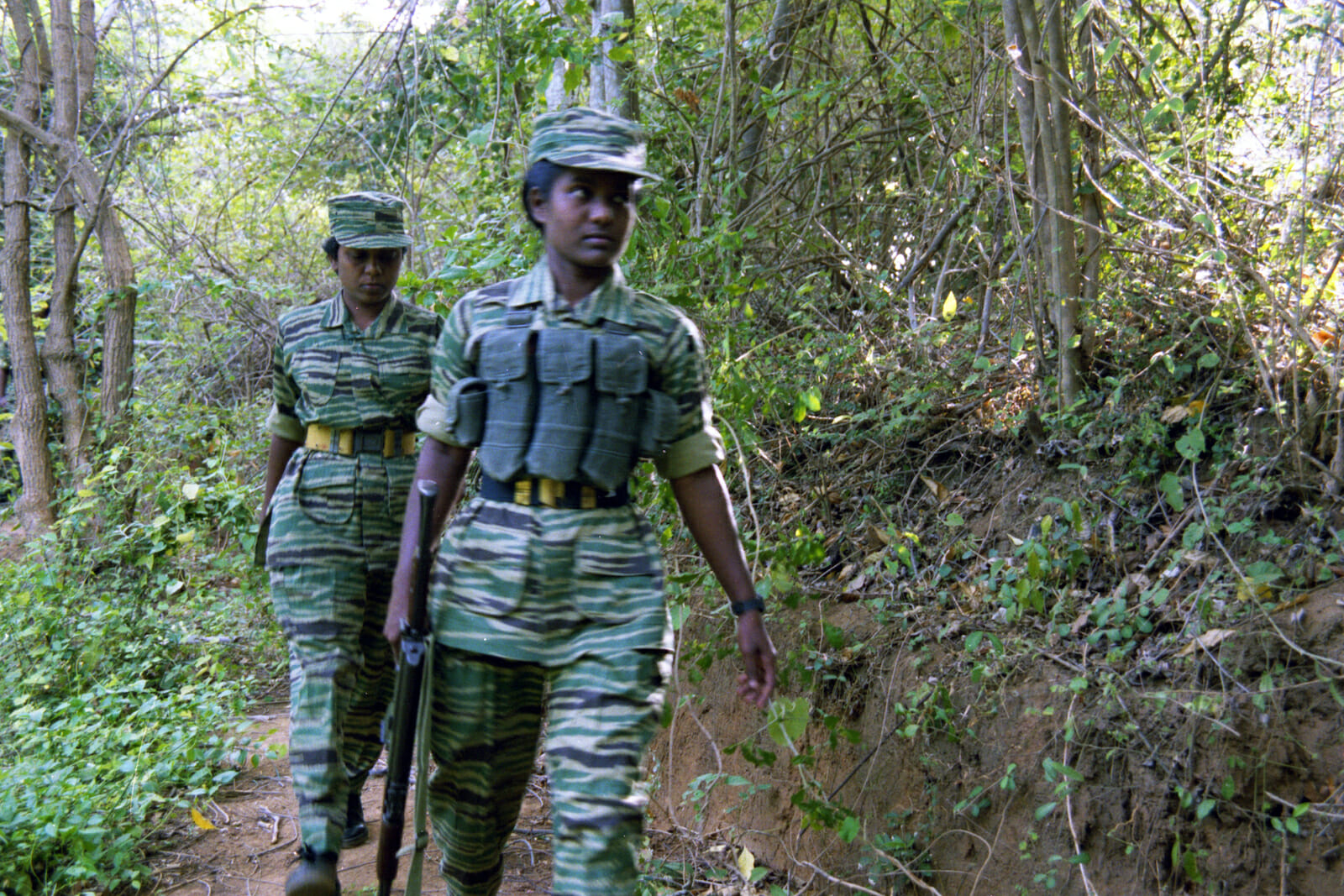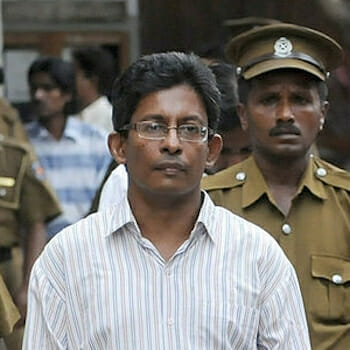
Karuna Amman Exposes Sri Lanka’s Post-War Reconciliation Sham
When a former rebel leader in Sri Lanka trumpeted his past military prowess at a rally to earn votes in the country’s forthcoming parliamentary elections, he provoked anger in sections of the country. Vinayagamoorthy Muralitharan, who as a rebel LTTE fighter answered to the nom de guerre, Colonel Karuna Amman, stirred resentment, not because of the veracity of his claims, but that he had shattered an alternate reality Sri Lanka has tried to create about the country’s civil war and its significance.
Speaking in his native Eastern Province, Karuna said, “I am more dangerous than COVID-19. Karuna has killed 2,000 to 3,000 Sri Lankan soldiers in one night at Elephant Pass when I was in the LTTE.”
It was not his Tamil audience however that took exception to the words but the Sinhala public which, now with the war over, is anxious to forget some embarrassing moments in the past.
Sri Lanka’s decades-old year civil war began when the country’s numerically smaller population of Tamils accused majority Sinhalese of using state power discriminatingly and agitated for secession, first through non-violence and later through armed warfare. The fighting, which saw over 100,000 deaths, including at least 40,000 in the final phase of the war, ended in May 2009 with the military defeat of the Liberation Tigers of Tamil Eelam (LTTE). A UN report accuses both Sri Lanka’s military and LTTE rebels of committing war crimes and crimes against humanity.
Following the end of the fighting, successive Sri Lanka governments have used Karuna for post-war pacification. It has been in two ways: as a symbol of purported national reconciliation, with a covert intention of promoting Sinhala interests, and to help build an alternate narrative about the civil war favourable to the Sinhala elite.
Karuna’s story in many ways follows the course of the war. He joined the LTTE in the 1980s and rose steadily up its ranks. He was known for his fearlessness and leadership skills. Among the battles he claims to have participated in was the assault on a well-fortified strategic military installation at Elephant Pass in April of 2000. It ended with the rout of the Sri Lanka Army and the rebels overrunning the garrison. It was to this incident he referred to in his speech.
Partly due to heavy losses suffered by both state forces and the rebels in a series of battles that year, they agreed to a pause in the fighting through peace talks, in which Karuna played a fairly important role. However, in late 2003, he was summoned on allegations of corruption to the rebel group’s headquarters in the north of the country by its leader Velupillai Prabhakaran. Karuna who then commanded the LTTE in the East decided to defect. Alleging discrimination of LTTE cadres from the East by those of the North, Karuna proposed setting up a semiautonomous command with him as the head.
The rupture resulted in fierce internecine fighting. The Sri Lanka government, officially in internationally facilitated peace negotiations with the LTTE did not initially interfere. But in 2004, Prime Minister Ranil Wickremesinghe’s government allegedly engineered Karuna’s evacuation from the cordon set up by Prabhakaran’s loyalists. The move undermined peace talks. As the in-fighting continued, Karuna headed a paramilitary group to support government troops combating the LTTE. It was involved in the extra-judicial killings of civilians, including a former parliamentarian.
When Mahinda Rajapaksa became president in November of 2005, Karuna switched support to him and his party. According to a U.S. embassy cable in May of 2007, Karuna’s paramilitaries extorted money from Tamil businessmen on the advice of then Defence Secretary Gotabaya Rajapaksa. (Gotabaya Rajapaksa is now the country’s president). Karuna also unleashed an orgy of violence mainly against Tamils in the Eastern Province by recruiting child soldiers and abducting and disappearing civilians in Colombo, with the support of the then government.
The post-war pacification process begins with Mahinda Rajapaksa, whose government annihilated the LTTE’s military machine. The essential contours of the process were consolidating Sinhala hegemony in Sri Lanka by disciplining Tamils for supporting secession. The disciplining included torturing Tamil civilians in internment camps, killing or disappearing many ex-LTTE cadres and potential civilian community leaders and, long-term, laying the foundations for the militarization of northeastern Sri Lanka.
It was in this pacification effort that Karuna served as a symbol of Sinhala-Tamil reconciliation and in building a narrative favourable to the Sinhala elite.
Sinhala-Tamil reconciliation as conceived by Rajapaksas had to be in an environment where the Tamils are militarily and politically suppressed. This meant that those who executed the repression – the Sinhala military and politicians – had to remain hegemons and hence not subject to accountability for wartime atrocities or violations in the post-war era. Since Tamils had to be punished collectively for supporting the armed rebellion, Sinhalese and Tamils sharing political power was ruled out. In this context, the only ‘reconciliation’ the Rajapaksa government could promote was through subservient Tamil individuals – loyalists like Karuna.
Therefore, Karuna – an ex-rebel – became a symbol admonishing Tamils for demanding rights in post-war Sri Lanka. Instead, they had to re-integrate with Sinhalese as second-class citizens and “live in brotherhood.” For his services, Karuna was allowed by Rajapaksa to transform his paramilitary group into a political party – the Tamil Makkal Viduthalai Puligal (TMVP) – in 2007 even as the civil war was going on and being appointed to Sri Lanka’s legislature as a member of parliament. His position in parliament was as a Rajapaksa puppet and not someone fighting for Tamil freedom or rights.
The Sri Lanka government also put on display the advantages for Tamils to reconcile with the Sinhalese and the state through personal loyalty to the Rajapaksas. They awarded Karuna perks. He was not only made minister of national integration and reconciliation in March 2009 but persuaded to abandon the TMVP and join the United Peoples’ Freedom Alliance, led by Mahinda Rajapaksa.
Karuna was also used in post-war pacification efforts to help Sri Lanka craft a new narrative about the civil war. Anyone following events in the country’s 30-year armed conflict would know that military fortunes for both combatants ebbed and flowed. However, the Sri Lanka government became chary of mentioning its military defeats. One such defeat was that mentioned by Karuna – the overrunning of the Elephant Pass base by the LTTE. Instead what Sri Lankan leaders loved to proclaim were (and are) the events that led to the death of Prabhakaran and overrunning of the area defended by an enfeebled LTTE.
Karuna contributed to this narrative by disparaging his former organization’s achievements in war. He gave interviews denigrating Prabhakaran’s policies as “totalitarian” and deriding the LTTE’s military successes. It is in this context that Karuna’s recent speech about killing more soldiers than COVID-19 shocks Sri Lankan “patriots.” The sentiment is a contradiction to what he had contributed for over a decade towards building the narrative Sri Lankan political leadership wanted.
That a single, almost throwaway sentence at an election rally has provoked such bitterness among the Sinhalese is because it shatters the edifice of Sri Lanka’s post-war pacification effort in a single stroke. The Sinhalese – especially the elite – were beginning to believe the narrative they had constructed about the past which obliterated portions they were eager to forget such as the battle for Elephant Pass. And they felt malleable yes men like Karuna were helping them construct this narrative and propagate it.
But Karuna’s speech to Tamil voters showed it was not the narrative denigrating LTTE military victories that appealed; it was the opposite. For Tamils to vote for him, Karuna appealed to Tamil pride, which despite the defeat, is even today centered on the armed struggle. Hence, he reminded his audience of that struggle and the heroic part he claimed to have played in it.
If what appeals to Tamils is that “Karuna killed 2,000-3,000 Sri Lanka soldiers in one night” rather repeating, puppet-like, sentiments belittling the LTTE that the Sinhala elite expected from Karuna and which he had dutifully done for over a decade, it also showed the failure of another aspect of the post-war pacification. It demonstrated that consolidating Sinhala interests in the guise of national reconciliation, where other groups and peoples are treated subordinate – as “minorities” – was not leading to either nation-building or integration. It was only perpetuating the cleavages.

